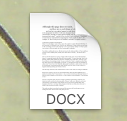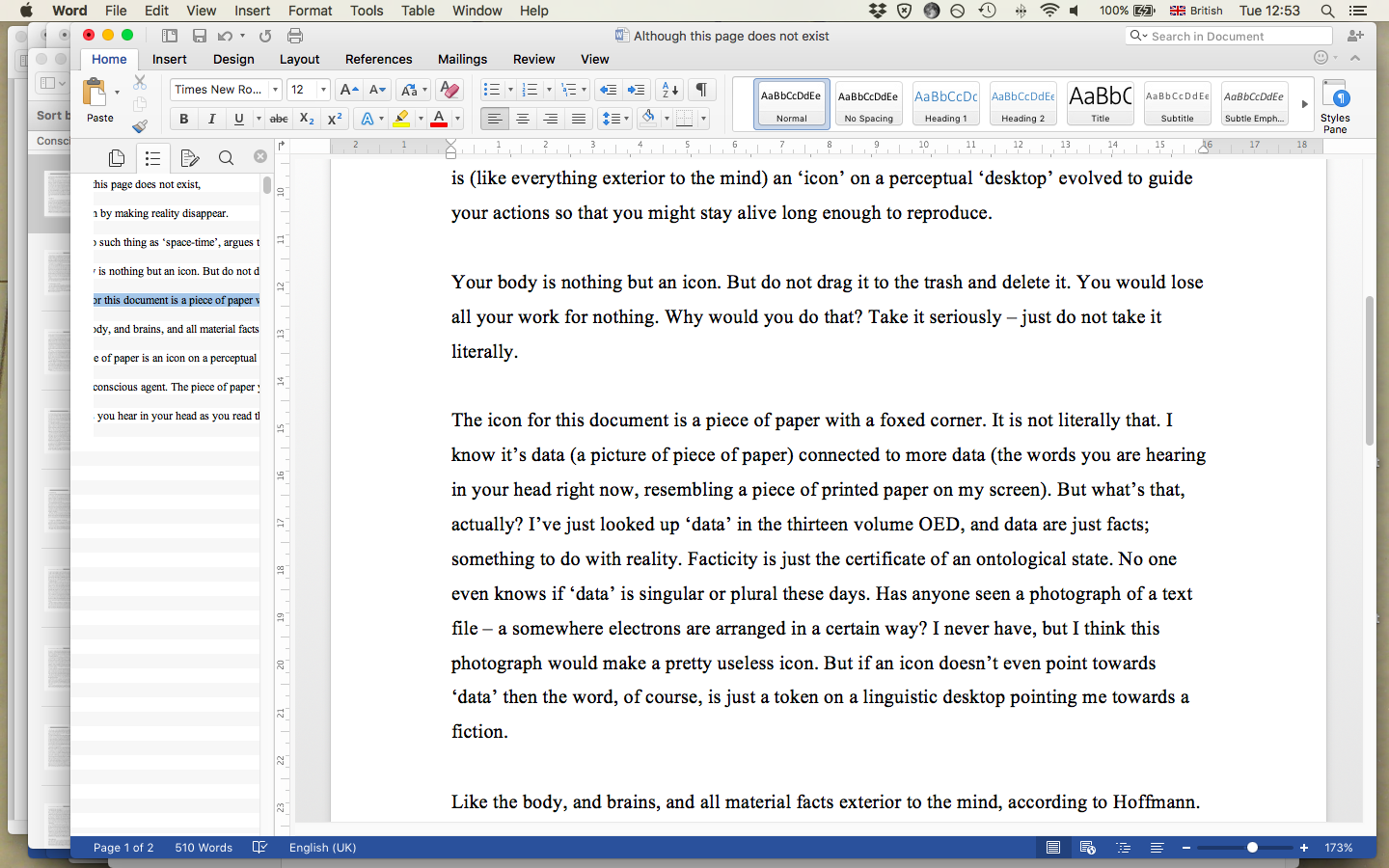Neil Bennun, 2017
—————— While I am writing this, and you’re hearing these words in your head, you are in a room holding a piece of paper. You and the room have three dimensions. And since you do not know how this paragraph will end, and you are no longer the person you were when you began to read it, it is clear that you also have a position in time, the dimension that makes it impossible to concentrate on anything. Spacetime is a vital principal of the consensus view of reality. This consensus depends on the uncontroversial belief that ‘reality’ is exterior to the mind and is delivered to the brain and nervous system by the sense organs (all of which are real), and that somewhere, mostly in the brain (which totally exists), representations of reality and consciousness are generated. Consciousness requires these representations of reality in order to be worthy of the name. Donald Hoffman of the University of California Irvine is a cognitive scientist, and he says the consensus is wrong. Let’s hear him out. Imagine him here now, a tall, thin suited datum with a scientist’s face. This is what he says. There is no piece of paper in your hand. You do not have a hand. This room has no dimensions. You have no co-ordinates in space-time. None of these things exist. He is very persuasive. He shows optical illusions and offers evidence from studies of animal perception. But you aren’t convinced at all. “I can see and feel things,” you say. “This piece of paper feels real. It’s definitely in my hand.” Donald Hoffmann is polite, but he’s heard this objection before. “We didn’t get where we are today by evolving to perceive reality,” he says; “we got here by evolving to survive long enough to reproduce. Look at these computer simulations of trait selection that demonstrate why beetles try and mate with beer bottles and why fish fight t-shirts.” The computer simulations are really persuasive. Fine. Natural selection doesn’t care whether you know what’s real or not. But there’s still the question of what it is one sees when one is seeing. “Think of spacetime as your desktop,” says Don. “All the objects you can see on that desktop are icons – helpful representations concealing a reality you don’t really need to understand. Chairs, bodies and all the other public objects are just guides for action offering us the best chances of staying alive long enough to reproduce.” But if my body is nothing but an icon then I might as well kill myself. You think. It’s you doing the thinking. But Don and I both know what you’re thinking. This doesn’t mean you can just drag your body to the trash and delete it (I explain, paraphrasing Don). You would lose all your work for nothing. Why would you do that? We take icons seriously – we just don’t take them literally. Look. This image shows a square of my desktop and the icon for the document I’m writing now.
It is, of course, a representation of a piece of paper with a foxed corner. The icon is data (a set of directions, for your computer, concealed in a representation of a piece of paper, for you to click on) connected to more data (the words you are hearing in your head right now, currently represented as letters on the representation of a piece of printed paper on my screen).
This is what the computer finds when you click on the icon. It is the document I’ve now finished and am editing. Does this look like data to you? What is (or are) data? Well, I’ve just looked it up. And it turns out that data are just facts. Something to do with reality. Facticity is the certification of an ontological state. So what does data look like? Has anyone ever seen a photograph of a text file – a place on some stable medium where electrons are arranged in a certain way? Even if this photograph were possible, it would make an entirely useless icon. If you could read the disposition of electrons you wouldn’t need an icon in the first place, of course, because you’d be able to look at the electrons and read the text and all the metadata, and – Regardless. In this niche of meaning, the word data itself is a token on a linguistic desktop concealing a tangle of different facts that would only get in the way of action. Who cares about electrons when you’re firing a gun that doesn’t exist into the notional brains of a fictional entity like a zombie? The only thing that matters then are points and health bars. In this way, argues Hoffmann, the room you are in, and the body or bodies in that room, and the piece of paper you are holding in your hand right now, are icons on a perceptual desktop evolved to allow us to accrue the maximum points (children) and health bars (food and not being eaten by dogs). And the un-representable, un-photographable reality these icons pointing towards, he says, is consciousness. Consciousness is the ultimate foundational fact, he says. It is not a recent arrival. It is first. It is the only datum worthy of that title. What we’re habituated to calling ‘the universe’ is a system of ‘conscious agents’, entangled at the quantum level, of which you are one. The piece of paper you hold in your hand is a token of your interaction with other conscious agents. It doesn’t exist, and you are not perceiving it in your brain. “Brains do not create consciousness,” he writes; “consciousness creates brains”. Brains disappear the moment you’re not thinking of them. Just like your body does, when one is asleep, in the retreat to the comparative reality of dreams. As an artefact of consciousness, dreams are more real than any bed. The words you hear in your head as you read this are more real than the paper you are reading them from. These words certify that you exist. You are welcome. Don smiles at you with his mouth, which is an event in a space-time that does not exist (the three spatial dimensions are nothing but a mode of error correction, he thinks, evolved to afford our species the choice of the best action given the best possible intelligence of the environment). But this smile calls for a reaction. You’re on. This is what consciousness is for. Make something happen. You begin to think the following. The Arsuk fjord on the south-western coast of Greenland is a wide, u-shaped valley six kilometres deep. It is rock entirely filled with material of a different substance, which is water. On the day we saw it, the rock was as dark as a wet comet and the sky was the colour of grief in the palaeolithic. The water was massy and vast and lay flat on the surface across the full valley. It was clear that both water and valley were materials of the same nature, being atoms in different arrangements. This water, we thought does not make good building material. It is useless for spaceships or jewellery. But it is a substance identical to rock in every other regard. Similarly, the air above it, which lay flat on the water, covering every centimetre of the rock, filled the valley from above. The air was broad and cold and full of atoms. There was a degree of entanglement (atoms of water in the gas, and atoms of rock in the water). But principally there was ROCK
Mark, J. T., Marion, B. B., & Hoffman, D. D. (2010), “Natural selection and veridical perceptions”, Journal of Theoretical Biology, 266, 504–515. Fields, C., Hoffman, D., Prakash, C., & Singh, M (2018), “Conscious agent networks: Formal analysis and application to cognition”, Cognitive Systems Research, 47,186–213 Singh, M., and Hoffman, D., “Natural Selection and Shape Perception: Shape as an Effective Code for Fitness,” cogsci.uci.edu/~ddhoff/ShapeFitness.pdf Arsuk Fjord, Greenland (2017), “Murder and Kidnap Men who Profit from Hydrocarbons”. |
Teksten blev udgivet i Entreentre pamflet 3 i forbindelse med udstillingen Natural Artifice- Architecture, Photography and the Construction of Reality, Oxford Glass Tank Gallery, 2018.

